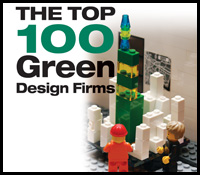 |
Green building for several years had been a novelty, an extra, sometimes expensive, set of bells and whistles to hang on signature buildings. But over the past two or three years, concerns about the environment and global warming have brought sustainable design to the forefront of the construction industry. And with the proliferation of green products and materials, and sudden surge in energy prices, building green no longer is an expensive luxury, but an often cost-effective alternative to traditional design.
In its first ever Top Green Design Firms survey, ENR has attempted to measure the green design market. The resulting ranking of the Top 100 Green Designers (see p. 120) is based on firms’ 2007 design revenue from projects registered with, and actively seeking certification from, third-party ratings groups under objective environmental or sustainable design standards, such the U.S. Green Building Council’s Leadership in Energy and Environmental Design standards.
|
The Top 100 generated design revenue of $1.74 billion from green projects in 2007. Of this total, $1.62 billion came from projects in the U.S., while $121.2 million came from projects abroad. Green design accounted for 7.4% of the Top 100’s total design revenue. But in the general building market, where green standards are pervasive, green projects accounted for $1.56 billion in revenue out of a total of $8.68 billion, or 18.0%, for the Top 100.
“No one expected green building to grow as quickly as it has,” says Paula Vaughan, associate principal and co-director of sustainable design for Perkins+Will. “I’m not seeing major resistance in any of the markets sectors.” She notes that owners in retail, restaurant, housing and health-care sectors all have become interested in sustainable design.
| + click to enlarge |
 |
Sustainable design even has penetrated the developer market, although some need encouragement from local laws, says Eli Sherman, president of Vanderweil Engineers. For example, Boston and Washington, D.C., have local sustainability laws mandating LEED certification for new projects. “That is pushing a lot of developers that might resist LEED,” says Sherman.
“We see a lot of developer work adopting sustainable design to take advantage of fast-track permitting in many local laws for high-level green building,” says Kirsten Ritchie, director of sustainable design at Gensler. She says tenants are pushing for energy conservation and good water and air circulation, forcing smart developers to adopt green designs.
Minnesota has adopted its own sustainability guide to encourage owners and designers to take aspects such as insulation, air conditioning and energy use into consideration, says Patrick Thibaudeau, vice president at Hammel Green and Abrahamson. This has led to an increase in owner interest in LEED.
“HGA has always been conscious of sustainability, but more recently owners have been coming to us and asking, ‘How many LEED accredited professionals do you have?’ or ‘How many LEED projects do you have?’”
In Seattle, local agencies decided to lead by example, says Teresa Burrelsman, sustainable design program director at Callison. She says that this has led to a chain reaction where commercial developers came next, then corporations that wanted green headquarters, then con-dos, hotels and ultimately retail. “Retail has been the last to warm up to green design,” she says, but lately Callison has seen a huge upsurge in retail requests.
Big Green Machine
For some designers, the size and scope of green projects are becoming larger. “We worked on the largest LEED certified building in the world, the Palazzo in Las Vegas,” a 3,000-room, $1.9-billion casino, says Sherman.
“We are doing the master plan for the New York City police academy in College Point, Queens,” says Vaughan of Perkins+Will. The $1-billion project will cover 35 acres and be designed to LEED standards, she says.
Gensler is helping design the MGM CityCenter in Las Vegas, says Ritchie. “That’s an 18-million-sq-ft project where each building will be designed to LEED silver standards,” she says. Flack+Kurtz is providing engineering services on that job, says David Cooper, president.
If there is a pocket of resistance to sustainability, it is in smaller projects. “When you have a small project, LEED requirements become increasingly more cumbersome, discouraging some small owners,” says Don Posson, managing director of Vanderweil’s Washington, D.C., office. “It is individual clients, not so much whole sectors, that are hesitant about green design,” says Jonathan Weiss, project architect at KlingStubbins. He says pharmaceutical companies and developers have been conservative in embracing LEED standards but seem to be coming around.
If there is one concern at the moment, it is the tightening credit markets. “With money at a premium, there is more concern about first costs,” says Sherman. Some developers are reluctant to go with sustainable designs that add cost unless you can show a quick payback, he says.
The tight financial markets mean that there are new opportunities in the tenant refit market. “The market for environmental upgrades of existing buildings is growing, particularly in Class B properties,” says Ritchie.
The gradual maturing of the sustainable design movement has had an impact on owners. “The level of sophistication among owners on sustainability has risen dramatically over the last few years,” says Michaella Wittmann, director of sustainable design solutions at HDR. “A few years ago, the owners’ goal was the [LEED certification] plaque. Now it’s the approach and results that are important, with LEED as just one measure of success.”
For others, owner reaction to sustainable design has been hard to categorize. Callison has seen an increase in clients who are interested in green design, sometimes because they’ve seen it in the news. “They’ll come to us and ask us...
 Related Links:
Related Links: 
Post a comment to this article
Report Abusive Comment